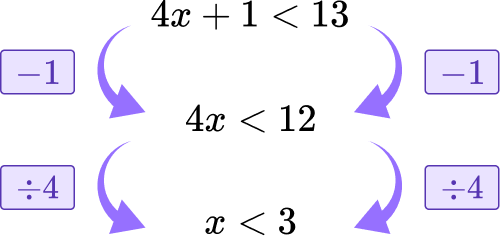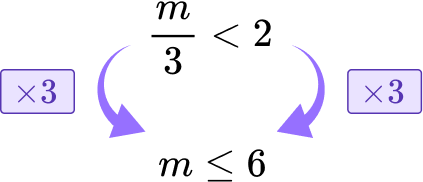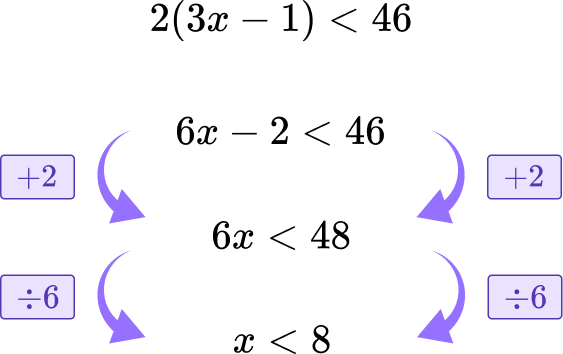High Impact Tutoring Built By Math Experts
Personalized standards-aligned one-on-one math tutoring for schools and districts
In order to access this I need to be confident with:
Linear equations Combining like terms Expanding expressions Types of numbersLinear inequalities
Here you will learn about linear inequalities, including what linear inequalities are and how to solve them.
Students will first learn about linear equations in expressions and equations in 7 th grade, and will build on that knowledge throughout high school.
What are linear inequalities?
Linear inequalities are inequalities where the power of the unknown in any algebraic expression is no higher than 1.
For example,
4x+1<13 which is read ‘4x+1 is less than 13’.
You can solve linear inequalities in the same way you solve linear equations, by using inverse operations to isolate the variable.
The difference is that the answer will be a range of solutions rather than a single value.

The solution is x<3. This means that x is any value less than 3.
Notice that the inequality symbol remains the same throughout the work and for the answer.
The solution is x is less than 3. This means x could be any real number less than 3 (for example, 2, 1.5, 1, 0, -1, -1000, etc.).
![[FREE] Linear Inequalities Worksheet (Grade 7 and Grade 9 to 12)](https://thirdspacelearning.com/wp-content/uploads/2024/02/Grade-6-to-12-Linear-Inequalities-Worksheet-listing-image.png)
[FREE] Linear Inequalities Worksheet (Grade 7 and Grade 9 to 12)
![[FREE] Linear Inequalities Worksheet (Grade 7 and Grade 9 to 12)](https://thirdspacelearning.com/wp-content/uploads/2024/02/Grade-6-to-12-Linear-Inequalities-Worksheet-listing-image.png)
Use this worksheet to check your 7th grade and 9th grade to 12th grade students’ understanding of linear inequalities. 15 questions with answers to identify areas of strength and support!
DOWNLOAD FREE![[FREE] Linear Inequalities Worksheet (Grade 7 and Grade 9 to 12)](https://thirdspacelearning.com/wp-content/uploads/2024/02/Grade-6-to-12-Linear-Inequalities-Worksheet-listing-image.png)
[FREE] Linear Inequalities Worksheet (Grade 7 and Grade 9 to 12)
![[FREE] Linear Inequalities Worksheet (Grade 7 and Grade 9 to 12)](https://thirdspacelearning.com/wp-content/uploads/2024/02/Grade-6-to-12-Linear-Inequalities-Worksheet-listing-image.png)
Use this worksheet to check your 7th grade and 9th grade to 12th grade students’ understanding of linear inequalities. 15 questions with answers to identify areas of strength and support!
DOWNLOAD FREENegative numbers and inequalities
If you multiply or divide the inequality by a negative number, the direction of the inequality reverses.
For example, to solve the inequality, -3x<30, divide both sides by -3.
Since multiplying or dividing by a negative reverses the direction of the inequality, this gives, x>-10.
This only happens when you multiply or divide an inequality by a negative value.
Graphing systems of linear inequalities
A system of linear inequalities, similar to a system of linear equations, is two or more inequalities in one or more variables. A system of linear inequalities will have a range of solutions.
Graphing a system of linear inequalities involves representing the solution region on a coordinate plane. The solution region is the area where the shaded regions of the inequalities overlap. This represents the solution of the system.
If you are graphing strict inequalities (< or >), then you would graph a dashed line.
If you are graphing not strict inequalities (\leq \text { or } \geq), you would graph a solid line.
For example,
Let’s graph the linear equations x \geq 2 and y<-1.

To graph the given inequalities, the first inequality, x \geq 2, will be graphed with a solid line and the second inequality, y<-1, will be graphed with a dashed line.
To find the solution region, you will need to shade in the boundary line for each inequality.
If the inequality symbol is > or \geq, you will shade in the top portion of the boundary line. For a vertical line, shade to the right.
If the inequality sign is < or \leq , you will shade in the bottom portion of the boundary line. For a vertical line, shade to the left.
For example,
The first inequality, x \geq 2, will be shaded to the right of the line.

The second inequality, y<-1, will be shaded below the dashed line.

The solution region is the area where the shaded regions of the inequalities overlap.

Note: The practice problems below do not cover graphing systems of linear inequalities.
What are linear inequalities?

Common Core State Standards
How does this relate to 7 th grade and high school math?
- Grade 7: Expressions and Equations (7.EE.B.4b)
Solve word problems leading to inequalities of the form px + q > r or px + q < r, where p, q, and r are specific rational numbers. Graph the solution set of the inequality and interpret it in the context of the problem.
For example: As a salesperson, you are paid \$50 per week plus \$3 per sale. This week you want your pay to be at least \$100. Write an inequality for the number of sales you need to make, and describe the solutions.
- High School: Reasoning with Equations and Inequalities (HSA.REI.B.3)
Solve linear equations and inequalities in one variable, including equations with coefficients represented by letters.
- High School: Reasoning with Equations and Inequalities (HSA.REI.D.12)
Graph the solutions to a linear inequality in two variables as a half plane (excluding the boundary in the case of a strict inequality), and graph the solution set to a system of linear inequalities in two variables as the intersection of the corresponding half-planes.
How to solve linear inequalities
In order to solve linear inequalities:
- Rearrange the inequality so that all the unknowns are on one side of the inequality sign.
- Rearrange the inequality by dividing by the \textbf{x} coefficient so that ‘\textbf{x}’ is isolated.
- Write your solution with the inequality symbol.
Linear inequalities examples
Example 1: one step linear inequality
Solve the inequality x-7>10.
- Rearrange the inequality so that all the unknowns are on one side of the inequality sign.
In this case, add ‘7’ to both sides.

2Rearrange the inequality by dividing by the \textbf{x} coefficient so that ‘\textbf{x}’ is isolated.
In this case, ‘x’ is already isolated.
3Write your solution with the inequality symbol.
In this example, you already have the solution, x>17.
Example 2: two step linear inequality
Solve the inequality 5x+4\le 19.
Rearrange the inequality so that all the unknowns are on one side of the inequality sign.
In this case, subtract ‘4’ from both sides.

Rearrange the inequality by dividing by the \textbf{x} coefficient so that ‘\textbf{x}’ is isolated.
In this case, you need to divide both sides by 5.

Write your solution with the inequality symbol.
The solution is x\le 3.
Note that multiplying or dividing by a positive number has no effect on the inequality sign itself.
Example 3: two step linear inequality with a fraction
Solve the inequality \cfrac{m}{3}+10<12.
Rearrange the inequality so that all the unknowns are on one side of the inequality sign.
In this case, you are subtracting ‘10’ from both sides.

Rearrange the inequality by dividing by the \textbf{x} coefficient so that ‘\textbf{x}’ is isolated.
In this case, the coefficient of x is \cfrac{1}{3}. So you divide both sides by \cfrac{1}{3}.
Or you can think of it as multiplying both sides by 3.

Write your solution with the inequality symbol.
The solution is m\le 6.
Example 4: linear inequality with negative coefficient
Solve the inequality 20-3x<8.
Note: Dealing with negatives.
There are two ways to deal with negative inequalities. The first is to move the negative term to the other side in order to make it positive. The second is to divide by the negative. Dividing by a negative reverses the direction of the inequality sign.
Let’s look at both ways of dealing with this.

Both methods give the same solution, x>4.
Example 5: compound inequality
Solve the inequality -3<4x+1\le 17.
Rearrange the inequality so that all the unknowns are on one side of the inequality sign.
This inequality compares three expressions. Any operation we do must be applied to all three expressions.
In this case, you are subtracting 1 from all three parts of the inequality.

Rearrange the inequality by dividing by the \textbf{x} coefficient so that ‘\textbf{x}’ is isolated.
In this case, you are dividing all three parts of the inequality by 4.

Write your solution with the inequality symbol.
The solution is -1<x\le 4.
Example 6: linear inequality with parentheses
Solve the inequality 6(y-3)\le 42.
Rearrange the inequality so that all the unknowns are on one side of the inequality sign.
Before we can move the terms here, we need to expand the parentheses.
6(y-3)=6y-18 so we now have,
6y-18\le 42.
Then you are adding 18 to both sides.

Rearrange the inequality by dividing by the \textbf{x} coefficient so that ‘\textbf{x}’ is isolated.
In this case, you are dividing both sides by 6.

Write your solution with the inequality symbol.
The solution is y\le 10.
Example 7: linear inequality with unknowns on both sides
Solve the inequality 5t+7>9t-13.
Rearrange the inequality so that all the unknowns are on one side of the inequality sign.
It is always easiest to move the term involving the smaller number of the variable. In this case, 5t is smaller than 9t, so you are subtracting ‘5t’ from both sides.

In this case, the next step would be to add 13 to both sides.

Rearrange the inequality by dividing by the \textbf{x} coefficient so that ‘\textbf{x}’ is isolated.
In this case, you are dividing both sides by 4.

Write your solution with the inequality symbol.
The solution is 5>t , which could also be written as t<5.
Example 8: parentheses and unknowns on both sides of an inequality
Solve the inequality 2(p+4)<6(4-p).
Rearrange the inequality so that all the unknowns are on one side of the inequality sign.
Before you can rearrange the inequality, you need to expand the parentheses.
It is always easiest to move the term involving the smaller number of the variable. In this case, -6p is smaller than 2p, so you are adding 6p to both sides.

Then you are subtracting 8 from both sides.

Rearrange the inequality by dividing by the \textbf{x} coefficient so that ‘\textbf{x}’ is isolated.
In this case, you are dividing both sides by 8.

Write your solution with the inequality symbol.
The solution is p<2.
Teaching tips for linear inequalities
- Introduce linear equalities by connecting them to real-world examples. Providing the real-world connection can help students connect the concepts to practical solutions.
- For students who are struggling with the concepts, using manipulatives, including algebra tiles, can help them physically manipulate and visualize the inequalities.
Easy mistakes to make
- Dropping the inequality
When solving inequalities, students may use the same method as solving equations. During this process, the inequality sign may be mixed up with the equality sign (=). It is important to ensure that the correct sign is used.
- Using the wrong operation
When working with equations and inequalities, you need to remember to use the inverse operation.
For example, to solve x+8<14, you need to subtract 8 from both sides not add 8 to both sides.
- Performing the operation to the wrong side
Make sure you perform the operation to the correct side of an inequality.
For example, to solve \cfrac{x}{3}\ge12, multiplying by 3 gives x\ge 36, not 3x\ge 12.
Related inequalities lessons
Practice linear inequalities questions
1) Solve the inequality 5x<30.





2) Solve the inequality 8x-5>27.





3) Solve the inequality \cfrac{x}{6}+2\ge 5.





4) Solve the inequality 30-3x\le 27.





5) Solve the inequality 13<5x-2\le 38.





6) Solve the inequality 2(3x-1)<46.





7) Solve the inequality 8x-2>5x+4.





8) Solve the inequality 2(3x-2)\le 14(4-x).





Linear inequalities FAQs
Calculators can be helpful for performing the computations, but are not typically used to directly solve or represent solutions. Calculators can be helpful when graphing inequalities or solving for systems of inequalities.
The key difference between a linear and quadratic inequality is the degree of polynomial expressions involved.
A linear inequality involves a polynomial degree of 1, which results in a straight line or half plane when graphed.
A quadratic inequality involves a polynomial degree of 2, which results in parabolas and regions above or below the x-axis.
Intervals notation is a standardized way to represent the solution set of linear inequalities on a number line. The basic forms of interval notation include closed interval, open interval, half-open or half-closed interval and infinite intervals.
The next lessons are
Still stuck?
At Third Space Learning, we specialize in helping teachers and school leaders to provide personalized math support for more of their students through high-quality, online one-on-one math tutoring delivered by subject experts.
Each week, our tutors support thousands of students who are at risk of not meeting their grade-level expectations, and help accelerate their progress and boost their confidence.

Find out how we can help your students achieve success with our math tutoring programs.
[FREE] Common Core Practice Tests (3rd to 8th Grade)
Prepare for math tests in your state with these 3rd Grade to 8th Grade practice assessments for Common Core and state equivalents.
Get your 6 multiple choice practice tests with detailed answers to support test prep, created by US math teachers for US math teachers!